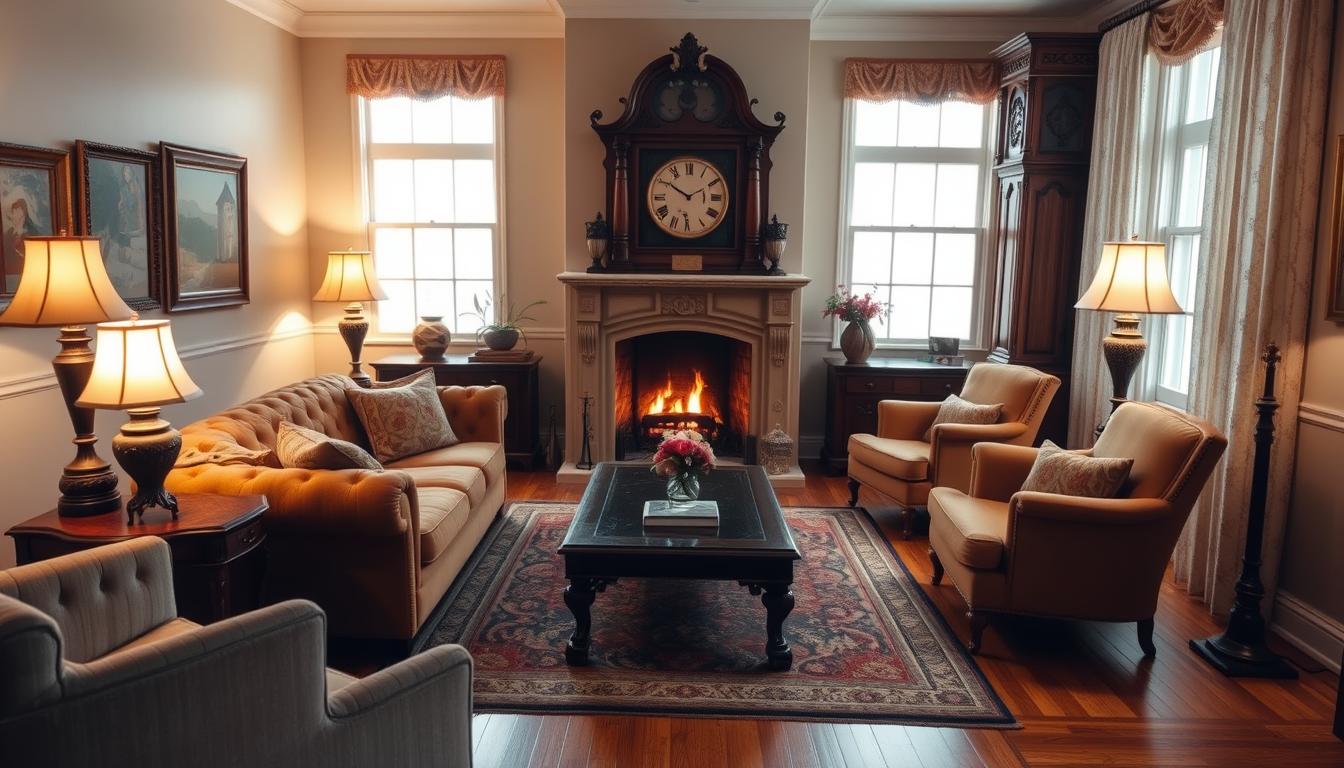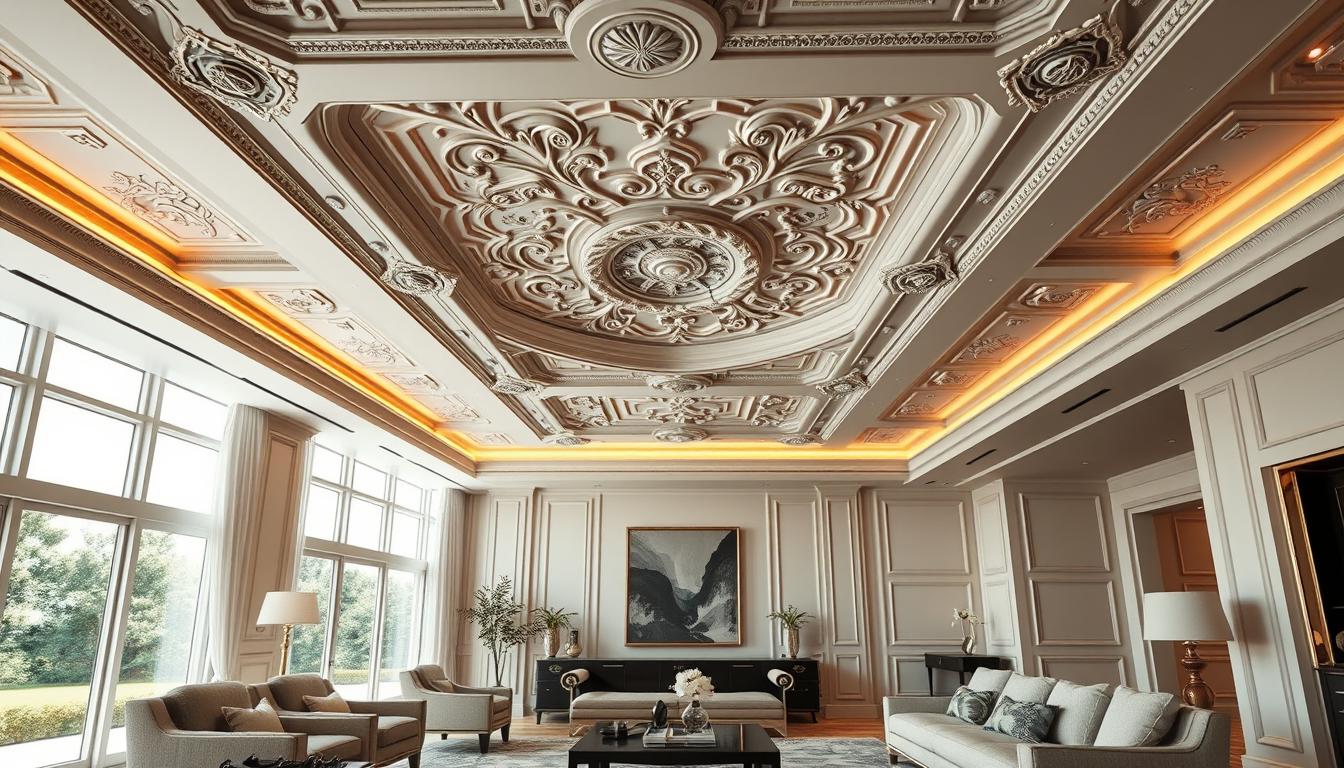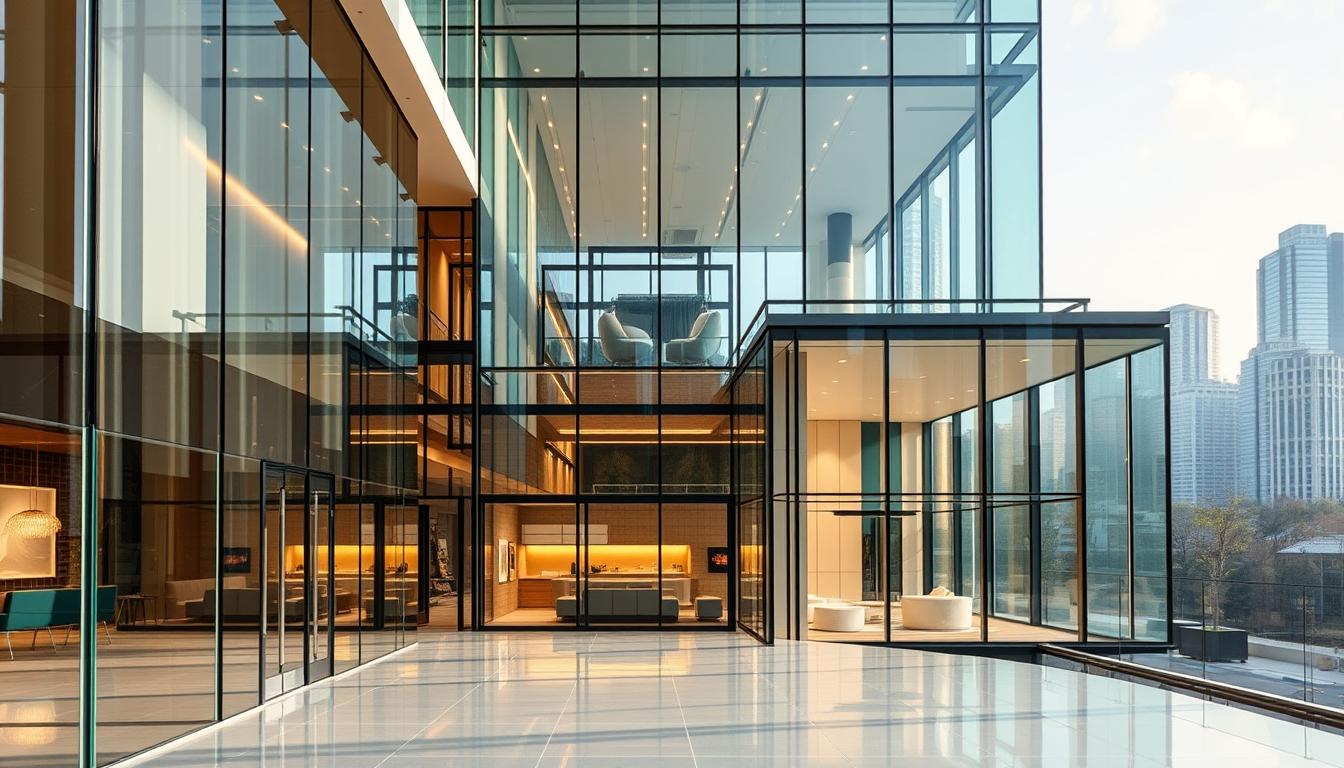The 1930s was a time of big change in home decor. It was filled with the luxury and shine of the Art Deco movement. Art Deco started in the 1910s and became a unique style by the 1920s and 1930s. It brought us the futuristic linear style seen in many buildings and homes from that time.
To capture the 1930s style in your home, mix modern and traditional. For a timeless home decor, use geometric patterns, metallic accents, and bold colors. These elements reflect the era’s spirit.
Key Takeaways
- Understand the influence of Art Deco on 1930s interior design.
- Identify key elements of 1930s home decor, such as geometric patterns and metallic accents.
- Learn how to incorporate these elements into your home for a timeless look.
- Discover how to balance modernity with traditional 1930s style.
- Create a cohesive aesthetic that honors the era’s design principles.
Understanding the 1930s Architectural Aesthetic
The 1930s was a time of big change in architecture. It brought styles that are still loved in American homes today. This era mixed practicality with fancy designs, showing the culture and society of the time.
Key Features of 1930s Architecture
1930s homes stood out with certain architectural features. They had brick patterns, stucco exteriors, and steeply pitched roofs. These not only made the homes strong but also made them look good.
Arched doorways and cottage windows were also big in this era. They became symbols of the 1930s style.
Inside, homes had built-in cabinetry, decorative motifs, and cozy fireplaces. These features were both useful and beautiful. They helped shape the historic home decor we love today.
Popular Materials Used
The materials used in the 1930s were key to its look. Hardwood floors were common, lasting long and looking great. Casement windows, with their fancy trim, added beauty and let in air.
If you want to add vintage interior design to your home, knowing the 1930s materials and features is important. By using these elements, you can make a space that respects history but also works for today’s needs.
Color Palettes That Define the Era
The 1930s was a time of big changes in home design. Colors played a big role in defining the era’s style. The era’s color schemes were both modern and nostalgic.
Typical Color Schemes
The 1930s colors were a mix of soft neutrals and deep, rich tones. Soft colors like beige and cream brought calm. Deep colors like emerald green and navy blue added elegance.
These colors were mixed to create a welcoming atmosphere. For example, a neutral background paired with bold colors on furniture and accents was common. This mix showed the era’s modern style while adding warmth.
How to Blend Colors for a Cohesive Look
To get a cohesive look in your 1930s-style home, blending colors is key. Start with a main color scheme, like neutrals with a bold accent. Then, use the 60-30-10 rule: 60% for the main color, 30% for a secondary, and 10% for an accent.
- Begin with a neutral base: Use soft neutrals for walls and big furniture.
- Add depth with rich colors: Use deep colors on smaller items, rugs, and accents.
- Balance with modern touches: Add modern elements to avoid a too-vintage feel.
By picking and blending colors wisely, you can make a retro home that’s both authentic and welcoming. Whether you’re fixing up a 1930s home or adding era touches to your modern space, knowing the era’s design principles will help you achieve a timeless look.
Furniture Designs and Styles of the 1930s
In the 1930s, furniture design changed a lot. It was influenced by Art Deco and International Style. This time saw new materials, new ways to make things, and a mix of old and new.
The 1930s loved luxury and new things in furniture. Art Deco was big, with its cool patterns and fancy materials. At the same time, International Style came in, with its simple lines and focus on being useful.
Iconic Furniture Pieces from the Decade
Some famous furniture from the 1930s includes:
- Chairs with tubular steel frames and leather or fabric upholstery
- Coffee tables with glass or metallic surfaces and cool patterns
- Cabinets and dressers with wood and metal details
- Sofas that are sleek and low, with fancy covers
These items showed off the design of the time. They also showed the skill and care in making furniture back then.
Selecting the Right Furniture for Your Home
Choosing furniture for a 1930s-style home needs a balance. Here are some tips:
- Find antique pieces or copies that match the era’s look.
- Think about the size and shape of furniture for your rooms.
- Try mixing different styles, like Art Deco and International Style, for a unique feel.
- Choose furniture made with quality materials and care, so it lasts long.
Using these tips, you can make a space that looks great and honors the 1930s. It will also show off your own style.
Iconic 1930s Interior Design Styles
The 1930s brought a blend of Art Deco’s glamour and rustic charm to interior design. This era’s styles reflected cultural and social shifts. They still inspire designers today.
Art Deco Influences
Art Deco dominated 1930s design, introducing geometric patterns and bold lines. It added sophistication to homes. The style used striking colors like golds, oranges, and blues, and monochrome palettes for opulence.
Luxurious materials like marble and metallic accents were key. They were paired with bold geometric patterns in rugs and wallpaper. This created a striking visual effect.
Rustic and Traditional Elements
Rustic and traditional elements contrasted with Art Deco’s glamour. They focused on natural materials like wood and stone. These created warm, inviting spaces.
- Wooden furniture with intricate carvings
- Stone fireplaces that became focal points in living rooms
- Traditional patterns on fabrics and wallpaper
These elements helped homeowners achieve a cozy, nostalgic feel. They balanced the modern glamour of Art Deco.
Flooring Options for a 1930 Home
To capture the essence of a 1930s home, it’s key to pick flooring that matches its unique style. Flooring greatly shapes the look of these historic homes.
Hardwood floors were a big hit in 1930s homes. They’re durable and look great forever. Let’s look at some classic hardwoods that can bring out the charm of your home.
Classic Hardwood Choices
Hardwood flooring was a big deal in the 1930s, with oak being a top choice. Oak’s rich grain and warm tones can make any room feel cozy and elegant.
Other classic hardwoods include:
- Maple, known for its light color and fine grain
- Walnut, which offers a darker, richer tone
- Pine, a softer wood that can add a cozy, rustic feel
These hardwoods can be stained in many shades. This lets homeowners pick the perfect look for their space.
| Hardwood Type | Characteristics | Ideal Use |
|---|---|---|
| Oak | Rich grain, warm tones | Living rooms, hallways |
| Maple | Light color, fine grain | Bedrooms, kitchens |
| Walnut | Dark, rich tone | Dining rooms, studies |
Incorporating Vintage Rugs
Vintage rugs can add warmth and character to a room, matching the hardwood flooring. When picking a vintage rug, think about its color and pattern. Make sure it fits with the room’s overall look.
Tips for Choosing Vintage Rugs:
- Opt for rugs with classic patterns such as florals or geometrics
- Consider the rug’s material and durability
- Ensure the rug’s color complements the hardwood flooring and other décor elements
By mixing classic hardwood flooring with vintage rugs, homeowners can create a timeless look. This honors the 1930s style beautifully.
Lighting Fixtures That Capture the Era
The 1930s brought big changes in lighting design. New materials and styles from this time still shape retro home style today. Lighting from then was not just for light; it showed off modern and industrial trends of the decade.
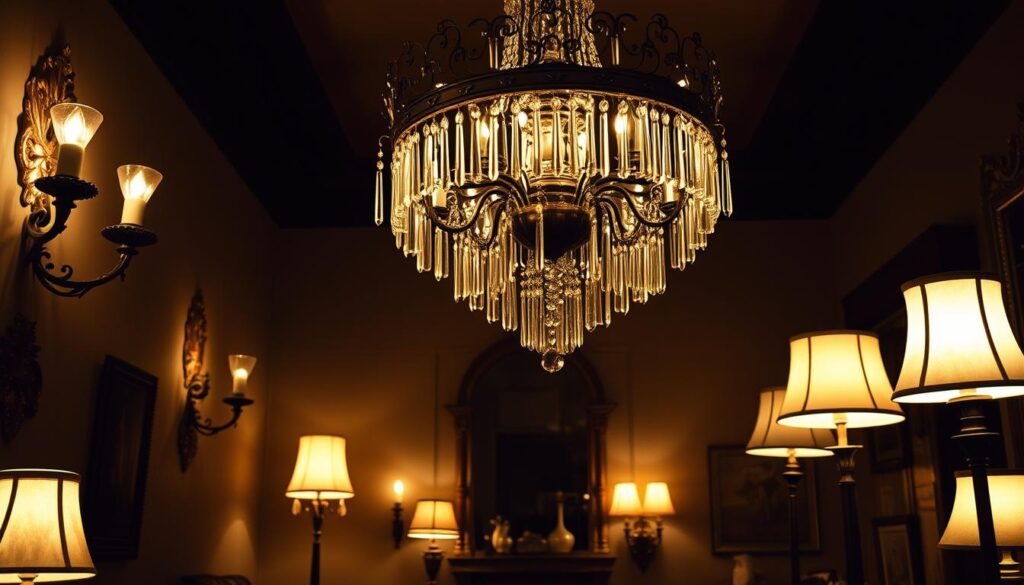
Popular Lighting Styles
In the 1930s, lighting was made in large numbers from materials like chrome, glass, and more. Modernist designs like globes or simple tubes were big hits. They brought elegance to homes.
“Lighting can make or break a room’s feel,” designers say. The 1930s were no different. Lighting was key to bringing the era’s classic style to life.
Choosing the Right Fixtures
To get a true 1930s vibe in your home, pick lighting that matches the era’s materials and styles. Look for chrome, glass, or metal, and go for modernist shapes. These are simple and geometric.
- Think about using globe lights or tube lights for a modern feel.
- Choose fixtures with a metallic finish, like chrome or brass, to show off industrial touches.
- Go for frosted or opaque glass shades to soften the light and warm up your space.
By using these tips, you can light up your home in a way that truly captures the 1930s spirit. It will also boost your home’s retro charm.
Wall Treatments: Paint, Wallpaper, and More
Wall treatments are key to capturing the 1930s interior design vibe. The right choice can take you back to the time of antique home furnishings and period-specific interior design. We’ll look at popular wall treatments from that era, including decorative wallpapers and bold paint colors.
Decorative Wallpaper Trends
The 1930s brought back decorative wallpaper, with designs from subtle textures to bold patterns. Block print wallpapers were big, featuring detailed designs that added elegance. These wallpapers often had floral motifs, stripes, and classic patterns that are still iconic today.
To add this trend to your home, try wallpaper on an accent wall or in a small room like a powder room. This makes a big impact without overwhelming the space.
How to Use Paint to Enhance Spaces
In the 1930s, paint was a big deal, with colors like mustard yellow, dark green, and poppy blue being popular. These bold colors added drama and sophistication to rooms.
To use paint like the 1930s, pick colors that match the era. Paint one wall in a bold color and the rest in a neutral shade. This creates a focal point while keeping the room balanced.
When picking paint colors, remember the 1930s loved rich, deep tones. Feel free to try bold colors for an authentic look. Or, go for softer shades to still capture the era’s spirit.
Accessories that Enhance 1930s Décor
The right accessories can make your 1930s home feel like it’s from another time. They add charm and character, blending vintage and modern styles. This mix captures the essence of 1930s interior design.
Vintage Décor Items to Consider
Vintage items are key to an authentic 1930s look. Think about adding console tables with detailed designs, vintage lights, and antique pieces. These items show off the era’s luxury.
Some must-have vintage items include:
- Antique clocks and timepieces
- Vintage artwork and prints
- Ornate mirrors and reflective surfaces
- Decorative vases and ceramics
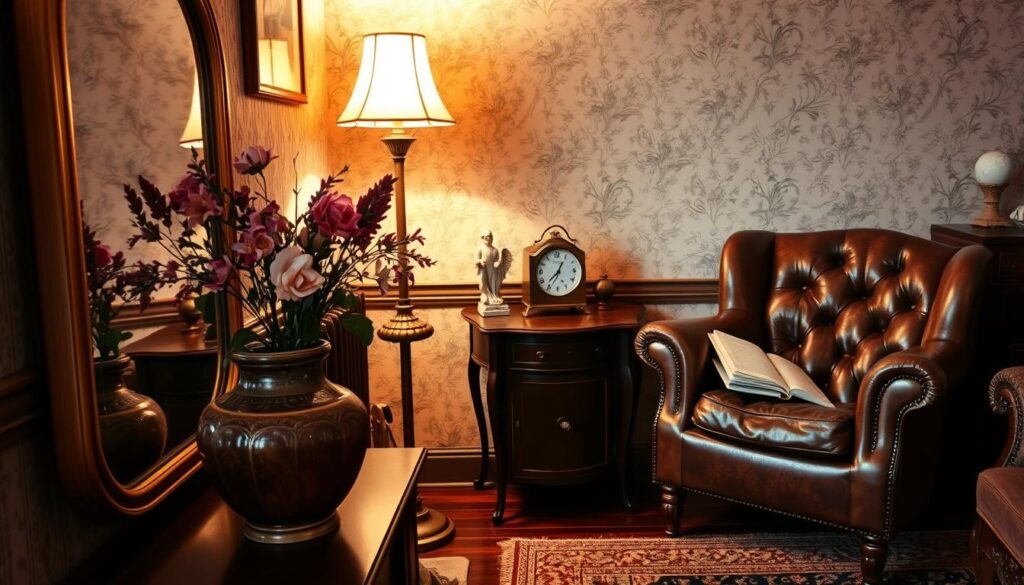
Modern Touches for a Timeless Appeal
Adding modern elements can make your 1930s home feel both old and new. This mix creates a unique look that honors the past while feeling modern.
Here are some ways to mix old and new:
- Incorporating modern art pieces alongside vintage décor
- Using contemporary lighting fixtures that echo the style of the era
- Adding sleek, modern furniture pieces that complement vintage items
| Vintage Element | Modern Twist | Result |
|---|---|---|
| Antique Console Table | Modern Sculptural Lighting | Unique Blend of Styles |
| Vintage Artwork | Contemporary Frame | Timeless Display |
| Ornate Mirror | Simple Modern Surround | Elegant Focal Point |
By mixing vintage and modern, you can create a 1930s-inspired home. It will feel both authentic and stylishly modern.
Outdoor Spaces Reflecting 1930s Style
Outdoor spaces from the 1930s are known for their clean lines and simple designs. They blend well with nature. We’ll look at garden designs, landscaping, and furniture trends from that time.
Garden Designs and Landscaping
Gardens in the 1930s were simple and functional, influenced by modernist style. They often had geometric patterns and minimal decorative elements. The goal was to merge the garden with nature.
To get a 1930s garden, use native plants and keep decor simple. Hardscaping elements like stone and concrete were common. They added a modern touch.
Outdoor Furniture Trends
Outdoor furniture in the 1930s was sleek and simple, reflecting modernist ideals. Wrought iron and teak were favored for their durability and classic look. Furniture focused on comfort and practicality.
To bring 1930s outdoor furniture into your home, look for pieces that are minimalist and durable. Using vintage or vintage-inspired furniture adds authenticity. This way, your outdoor space will feel like a piece of history, yet still be inviting.
Bringing 1930s Style into Modern Living
To mix 1930s charm with today’s style, we find a balance. This blend makes our homes feel both old and new. It’s a timeless look that’s both nostalgic and modern.
Creating a Cohesive Look
We can mix curved bay windows and vintage furniture with today’s comforts. Choosing the right materials is key. It helps create a look that honors the 1930s while feeling modern.
Maintaining Authenticity
To keep the 1930s feel, we focus on its defining traits. Rich colors and ornate details are key. Adding these to our homes makes them elegant and welcoming.
Embracing the 1930s style lets us create a beautiful, functional home. It’s a timeless decor that stands the test of time.
